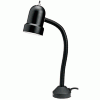Odie
Panning for Montana gold, with Betsy, the mule!
Sometimes I wonder if there is Divine intervention in some of the coincidental things that happen in my shop! :cool2:
The other day, the switch on the light for my wet grinder went belly up! :mad:
My choices were to go down and buy another light, or fix this one......I chose the latter. I took a regular light switch used in a wall box....cut it up and installed it on the neck of the lamp with a bunch of electrical tape....looks jury-rigged, works great! (splice and connections were done correctly, but necessity of the moment meant the whole unit was mounted to the neck with the electrical tape)
This lamp has a magnetic base......and......well.....to make the story short, I set the darn thing on the lathe headstock.....I had been working on a bowl when the switch failure occurred. Shazam! What an improvement in my lathe lighting.
For the past 25yrs, I had been using a single adjustable neck lamp and a couple of 4' fluorescent bulbs suspended over the lathe......I always thought I was satisfied with that......until the other day!
There's something very good about the sweep of two incandescent bulbs from different directions, very close to your work.........plus the overhead fluorescent bulbs.
I'll never go back to the way it was now!
While we're on the subject, you might as well tell us about the lighting on your lathe......comments and suggestions are always welcome......and, I'm always interested in hearing and seeing how others are handling situations in their shop. :cool2: Pictures are always great to see........!
ooc
The other day, the switch on the light for my wet grinder went belly up! :mad:
My choices were to go down and buy another light, or fix this one......I chose the latter. I took a regular light switch used in a wall box....cut it up and installed it on the neck of the lamp with a bunch of electrical tape....looks jury-rigged, works great! (splice and connections were done correctly, but necessity of the moment meant the whole unit was mounted to the neck with the electrical tape)
This lamp has a magnetic base......and......well.....to make the story short, I set the darn thing on the lathe headstock.....I had been working on a bowl when the switch failure occurred. Shazam! What an improvement in my lathe lighting.
For the past 25yrs, I had been using a single adjustable neck lamp and a couple of 4' fluorescent bulbs suspended over the lathe......I always thought I was satisfied with that......until the other day!
There's something very good about the sweep of two incandescent bulbs from different directions, very close to your work.........plus the overhead fluorescent bulbs.
I'll never go back to the way it was now!
While we're on the subject, you might as well tell us about the lighting on your lathe......comments and suggestions are always welcome......and, I'm always interested in hearing and seeing how others are handling situations in their shop. :cool2: Pictures are always great to see........!
ooc
Attachments
Last edited:








